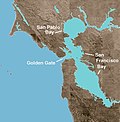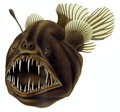The pelagic zone consists of the water column of the open ocean and can be further divided into regions by depth. The word pelagic is derived from Ancient...
14 KB (1,451 words) - 18:48, 9 July 2024
The abyssal zone or abyssopelagic zone is a layer of the pelagic zone of the ocean. The word abyss comes from the Greek word ἄβυσσος (ábussos), meaning...
19 KB (2,449 words) - 23:30, 3 November 2024
predominantly a pelagic species but forms large aggregations near the seabed when it spawns on banks of gravel. Two types of fish inhabit the demersal zone: those...
6 KB (755 words) - 22:53, 1 October 2022
Pelagic fish live in the pelagic zone of ocean or lake waters—being neither close to the bottom nor near the shore—in contrast with demersal fish that...
74 KB (8,402 words) - 02:21, 27 September 2024
submarine ridges and deep ocean trenches known as the hadal zone. For comparison, the pelagic zone is the descriptive term for the ecological region above...
20 KB (2,466 words) - 00:46, 25 September 2024
that are commonly assumed to reside in the pelagic zone often rely heavily on resources from the littoral zone. Littoral areas of ponds and lakes are typically...
17 KB (2,193 words) - 11:51, 14 April 2024
The mesopelagic zone (Greek μέσον, middle), also known as the middle pelagic or twilight zone, is the part of the pelagic zone that lies between the photic...
50 KB (6,027 words) - 21:14, 10 September 2024
light penetration, as discussed in pelagic zone. The upper 200 metres is referred to as the photic or euphotic zone. This represents the region where enough...
25 KB (2,958 words) - 13:25, 2 November 2024
Glaucus atlanticus (redirect from Pelagic sea slug)
species of sea slug in the family Glaucidae. These sea slugs live in the pelagic zone (open ocean), where they float upside-down by using the surface tension...
19 KB (1,955 words) - 13:06, 25 September 2024
Bioluminescence (section Pelagic zone)
bioluminescent organisms across the pelagic water column. The dispersal of bioluminescence across different depths in the pelagic zone has been attributed to the...
75 KB (8,132 words) - 04:30, 7 November 2024
pelagic zone. Within the neritic, marine biologists also identify the following:[citation needed] The infralittoral zone is the algal-dominated zone down...
6 KB (676 words) - 06:40, 4 June 2024
of the number of animals) on our planet. Abyssal zone Benthic zone Hadal zone Pelagic zone Photic zone Earle, Sylvia A.; Thorne-Miller, Boyce (1999). The...
10 KB (1,123 words) - 11:32, 23 September 2024
The bathypelagic zone or bathyal zone (from Greek βαθύς (bathýs), deep) is the part of the open ocean that extends from a depth of 1,000 to 4,000 m (3...
49 KB (5,362 words) - 13:11, 13 May 2024
metres (660 ft), seaward from the coast into the open ocean with its pelagic zone. It is the region of open sea beyond the edge of the continental shelf...
5 KB (588 words) - 09:19, 25 June 2024
Water column (section Pelagic zones)
Descriptively, the deep sea water column is divided into five parts—pelagic zones (from Greek πέλαγος (pélagos), 'open sea')—from the surface to below...
8 KB (832 words) - 06:33, 3 September 2024
intertidal zone or foreshore is the area above water level at low tide and underwater at high tide; in other words, it is the part of the littoral zone within...
15 KB (1,786 words) - 23:04, 27 September 2024
some inhabit freshwater environments and, with the exception of the pelagic zone, marine environments as well. They comprise over 110,000 named species...
56 KB (4,815 words) - 23:40, 27 October 2024
Ocean (section Oceanic zones)
split the ocean into vertical and horizontal zones based on physical and biological conditions. The pelagic zone is the open ocean's water column from the...
127 KB (16,967 words) - 06:20, 1 November 2024
Benthic-pelagic coupling are processes that connect the benthic zone and the pelagic zone through the exchange of energy, mass, or nutrients. These processes...
13 KB (1,636 words) - 12:38, 6 June 2024
contrasted with holoplankton, which are planktonic organisms that stay in the pelagic zone as plankton throughout their entire life cycle. After a period of time...
12 KB (1,573 words) - 03:12, 4 January 2024
move. Most colonies are long, thin, transparent floaters living in the pelagic zone. Like other hydrozoans, some siphonophores emit light to attract and...
32 KB (3,546 words) - 06:46, 27 August 2024
Ecology of the San Francisco Estuary (redirect from Pelagic Ecology of the Low Salinity San Francisco Estuary)
the Bay Area. Habitat loss at the edges of the pelagic zone is thought to create a loss of native pelagic fish species, by increasing vulnerability to predation...
64 KB (8,430 words) - 00:06, 1 November 2024
large predatory fish. See forage fish. Bathypelagic – the open ocean or pelagic zone that extends from a depth of 1000 to 4000 meters below the ocean surface...
56 KB (7,906 words) - 03:37, 7 September 2024
extend far below the epipelagic zone, and support very different types of pelagic fishes adapted to living in these deeper zones. In deep water, marine snow...
59 KB (6,840 words) - 21:45, 28 October 2024
some time in the pelagic zone. As the fish came close to breeding, they began to spend a greater amount of time in the pelagic zone. With the lack of...
22 KB (2,560 words) - 03:28, 30 October 2024
ISimangaliso Marine Protected Area (section Zonation)
inshore controlled pelagic zone 1: (500 m north of the Kosi north bank to 2 km south of the mouth of the Kosi Lake) A controlled pelagic zone between the high...
55 KB (7,213 words) - 22:02, 29 August 2024
Biome (section Holdridge (1947, 1964) life zones)
fir (Abies alba) Pruvot (1896) zones or "systems": Littoral zone Pelagic zone Abyssal zone Longhurst (1998) biomes: Coastal Polar Trade wind Westerly Other...
46 KB (4,828 words) - 14:44, 28 October 2024
Lake ecosystem (section Zones)
seasonally stratified. Ponds and pools have two regions: the pelagic open water zone, and the benthic zone, which comprises the bottom and shore regions. Since...
41 KB (5,307 words) - 08:38, 18 June 2024
eutrophication-related dead zone formations, the increase in nutrient availability can lead to temporary rises in select yields among pelagic populations, such...
84 KB (9,152 words) - 00:05, 1 November 2024
and a large number of gill rakers, typical of fish that feed in the pelagic zone. The mean size of adults is 36–38 cm and 0.6 to 0.8 kg, though the maximum...
6 KB (670 words) - 15:56, 27 October 2024





















